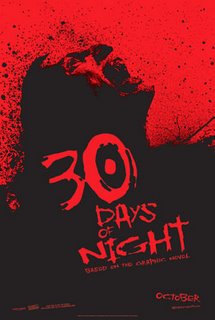
When the graphic novel that inspired
30 Days of Night came out a few years ago, I was not one of its fans. So, why did I walk out of the film adaptation with a mostly positive impression? A lot of it I think has to do with the strong visual sense of director David Slade. Slade burst onto the scene last year with the psychological thriller,
Hard Candy. It was one of my favorite films of last year, and when I heard he was attached to this project, I was faced with a bit of dread. After all, I have seen many filmmakers make wonderful debuts, only to be stuck behind junk by the Hollywood machine.
30 Days of Night is nowhere near the film of his earlier work, but it's effective for the most part, and is able to create a surprising amount of tension from a simple yet effective premise.
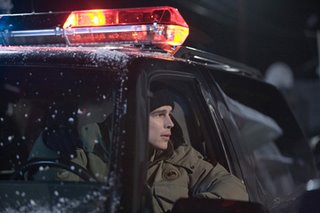
The small town of Barrow is located at the most northern point in the US in Alaska. Every year, the town is hit by a weather phenomenon where the sun completely disappears for one month, and the surrounding area is thrown into endless night for 30 days. As the people of Barrow start to prepare for this year's occurrence, ominous signs start to pop up throughout the town during the sun's final hours. The local dogs are the first to pick up on it (somehow, animals are always the first to detect evil presences in horror films), but are quickly massacred by someone or something. The brutal killings are brought to the attention to the town's Sheriff, Eben Oleson (Josh Hartnett), a tortured man who is still coming to terms with the fact his beloved wife Stella (Melissa George) has recently left him. More signs continue to arise, including the arrival of a Stranger (Ben Foster), who offers cryptic warnings of death from his cell at the local jail. As night descends, mysterious people who move at inhuman speed are sighted, and more murders are reported. As Eben and a small group of survivors (including ex-wife Stella) try to figure out what's going on, they begin to realize that Barrow is under siege by a clan of vampires who have decided to take advantage of the whole "sun not rising for 30 days" deal, and turn the entire town into their personal all you can eat buffet. Eben and the others must now find a way to survive and avoid detection for the next month.
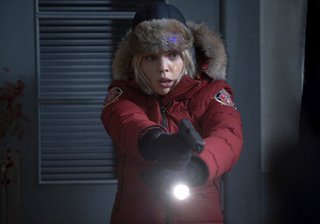
The film version of
30 Days of Night fixes one of my major problems I had with the original source graphic novel, in that I was not fond of the artstyle. Depicted in what I can best describe as highly stylized graffiti art, with loose lines and color scheme, it made the panels look sometimes rough and unfinished. This was obviously intentional, as the creators were probably going for a "gritty" look, but it just did not appeal to me. For the film adaptation, director Slade and cinematographer Jo Willems (
Rocket Science) have created an appropriately icy and isolated look that really heightens the tension. There is something almost deceptively calm about the gentle falling snow in a lot of the scenes, and the silence and isolation at first seems peaceful. The look of the film is highly reminiscent of John Carpenter's
The Thing, and I mean that in a good way. Of course, soon, we start to see shadowy figures watching the townspeople in the background. Sometimes we get brief glimpses of them right before they lunge and attack, and sometimes they just seem to be lying in wait, and the characters in the foreground don't even notice them. The opening half hour, which is a mixture of everyday life combined with sharp, bloody, ominous signs that something is about to happen is when the film is at its most effective. The movie does a great job of drawing out the suspense, and manages to keep the vampires out of our sight just long enough to intrigue us. Even though they are lurking about almost from the opening scene, we don't get to actually get a good look at them until the film is good and ready. Slade certainly shows his knowledge that sometimes with horror, less is more.
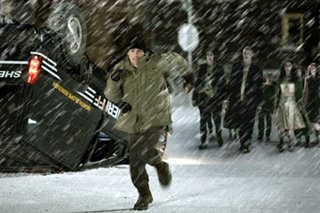
When the vampires finally do make their appearance, the payoff does not exactly match the build up, but it still manages to be effective in some way. I liked that the vampires are depicted mainly as soulless, unfeeling killers that almost seem to be hunting for sport. They treat each kill with a casualness that is certainly chilling. Rather than making them bombastic villains, they merely seem to be taking advantage of a golden opportunity. They even get to display a bit of cunning, such as an effective sequence where they force a teenage girl to walk down the street, crying out for help, hoping that her cries will lure survivors and good samaritans out of hiding. Despite all this, the vampires still come across as disappointing in some way. Aside from that trap they try to pull to lure out people, their plan seems disappointingly simple, and consists mainly of standing around and waiting for people to come out of hiding, them come charging at them. They can certainly move at great speeds, but only seem to utilize it at the last minute when they're right next to the victim. The vampires talk to each other in a bizarre language that sounds like a cross between backwards English and the T-Rex shriek from the
Jurassic Park films, which is subtitled in English, but mainly they use as little words as possible and prefer to lurk in the dark shadows. This is, after all, where they are the most effective in the film, and where I liked them the best.
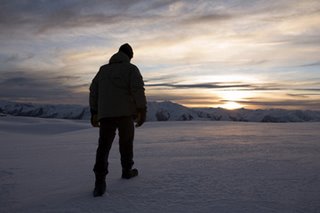
It's the human cast that winds up suffering the most, and that brings me to my big problem with
30 Days of Night. Unlike the look the film, the emotionally thin characters that are almost impossible to care about have been carried over from the original graphic novel to the screenplay. The comic's original writer, Steve Niles, co-wrote the script along with Stuart Beattie (
Derailed) and Brian Nelson (
Hard Candy), and it's a shame he didn't see this as an opportunity to improve upon his original sketchy characterizations. Aside from Eben and Stella having some marital woes, not much about the characters is revealed. The actors do a fine enough of a job filling the roles, but they are given no strong foundations with which to build genuine characters, other than a bare personality trait or two. A twist in the third act concerning one of the main characters comes across a bit weaker than it should, because we don't feel as attached as we should to the person. Besides this, the movie also has a tough time depicting the passing of time. Aside from some subtitles that pop up from time to time to inform the audience how many days have passed, the audience could easily be fooled into thinking only a day or two has passed. The characters don't go through the usual physical changes we'd expect of them hiding themselves away for a month, aside from a small (and oddly trimmed) beard forming on Josh Hartnett's face. It's kind of hard to get involved when the characters barely seem to be affected by the sudden isolation.
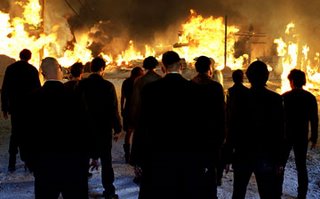 30 Days of Night
30 Days of Night is a movie that works better visually than on the written page. When we are distracted by the beautiful winter scenery, the stunning visuals (there's a lengthy overhead show of the town as it falls into ruin and chaos during the initial vampire attack that is effectively chilling), and the passable, if slight, performances, everything's fine. It's only when we're forced to focus on the underdeveloped characters and the sometimes clunky dialogue that the cracks begin to show. The movie manages to entertain and thrill just enough that I'm recommending it. David Slade obviously shows here he can make a great looking horror film, and knows how to stage a suspenseful sequence. If he can get the characters and the heart to go along with it, nothing could stop him.
0 comments
 When the graphic novel that inspired 30 Days of Night came out a few years ago, I was not one of its fans. So, why did I walk out of the film adaptation with a mostly positive impression? A lot of it I think has to do with the strong visual sense of director David Slade. Slade burst onto the scene last year with the psychological thriller, Hard Candy. It was one of my favorite films of last year, and when I heard he was attached to this project, I was faced with a bit of dread. After all, I have seen many filmmakers make wonderful debuts, only to be stuck behind junk by the Hollywood machine. 30 Days of Night is nowhere near the film of his earlier work, but it's effective for the most part, and is able to create a surprising amount of tension from a simple yet effective premise.
When the graphic novel that inspired 30 Days of Night came out a few years ago, I was not one of its fans. So, why did I walk out of the film adaptation with a mostly positive impression? A lot of it I think has to do with the strong visual sense of director David Slade. Slade burst onto the scene last year with the psychological thriller, Hard Candy. It was one of my favorite films of last year, and when I heard he was attached to this project, I was faced with a bit of dread. After all, I have seen many filmmakers make wonderful debuts, only to be stuck behind junk by the Hollywood machine. 30 Days of Night is nowhere near the film of his earlier work, but it's effective for the most part, and is able to create a surprising amount of tension from a simple yet effective premise. The small town of Barrow is located at the most northern point in the US in Alaska. Every year, the town is hit by a weather phenomenon where the sun completely disappears for one month, and the surrounding area is thrown into endless night for 30 days. As the people of Barrow start to prepare for this year's occurrence, ominous signs start to pop up throughout the town during the sun's final hours. The local dogs are the first to pick up on it (somehow, animals are always the first to detect evil presences in horror films), but are quickly massacred by someone or something. The brutal killings are brought to the attention to the town's Sheriff, Eben Oleson (Josh Hartnett), a tortured man who is still coming to terms with the fact his beloved wife Stella (Melissa George) has recently left him. More signs continue to arise, including the arrival of a Stranger (Ben Foster), who offers cryptic warnings of death from his cell at the local jail. As night descends, mysterious people who move at inhuman speed are sighted, and more murders are reported. As Eben and a small group of survivors (including ex-wife Stella) try to figure out what's going on, they begin to realize that Barrow is under siege by a clan of vampires who have decided to take advantage of the whole "sun not rising for 30 days" deal, and turn the entire town into their personal all you can eat buffet. Eben and the others must now find a way to survive and avoid detection for the next month.
The small town of Barrow is located at the most northern point in the US in Alaska. Every year, the town is hit by a weather phenomenon where the sun completely disappears for one month, and the surrounding area is thrown into endless night for 30 days. As the people of Barrow start to prepare for this year's occurrence, ominous signs start to pop up throughout the town during the sun's final hours. The local dogs are the first to pick up on it (somehow, animals are always the first to detect evil presences in horror films), but are quickly massacred by someone or something. The brutal killings are brought to the attention to the town's Sheriff, Eben Oleson (Josh Hartnett), a tortured man who is still coming to terms with the fact his beloved wife Stella (Melissa George) has recently left him. More signs continue to arise, including the arrival of a Stranger (Ben Foster), who offers cryptic warnings of death from his cell at the local jail. As night descends, mysterious people who move at inhuman speed are sighted, and more murders are reported. As Eben and a small group of survivors (including ex-wife Stella) try to figure out what's going on, they begin to realize that Barrow is under siege by a clan of vampires who have decided to take advantage of the whole "sun not rising for 30 days" deal, and turn the entire town into their personal all you can eat buffet. Eben and the others must now find a way to survive and avoid detection for the next month. The film version of 30 Days of Night fixes one of my major problems I had with the original source graphic novel, in that I was not fond of the artstyle. Depicted in what I can best describe as highly stylized graffiti art, with loose lines and color scheme, it made the panels look sometimes rough and unfinished. This was obviously intentional, as the creators were probably going for a "gritty" look, but it just did not appeal to me. For the film adaptation, director Slade and cinematographer Jo Willems (Rocket Science) have created an appropriately icy and isolated look that really heightens the tension. There is something almost deceptively calm about the gentle falling snow in a lot of the scenes, and the silence and isolation at first seems peaceful. The look of the film is highly reminiscent of John Carpenter's The Thing, and I mean that in a good way. Of course, soon, we start to see shadowy figures watching the townspeople in the background. Sometimes we get brief glimpses of them right before they lunge and attack, and sometimes they just seem to be lying in wait, and the characters in the foreground don't even notice them. The opening half hour, which is a mixture of everyday life combined with sharp, bloody, ominous signs that something is about to happen is when the film is at its most effective. The movie does a great job of drawing out the suspense, and manages to keep the vampires out of our sight just long enough to intrigue us. Even though they are lurking about almost from the opening scene, we don't get to actually get a good look at them until the film is good and ready. Slade certainly shows his knowledge that sometimes with horror, less is more.
The film version of 30 Days of Night fixes one of my major problems I had with the original source graphic novel, in that I was not fond of the artstyle. Depicted in what I can best describe as highly stylized graffiti art, with loose lines and color scheme, it made the panels look sometimes rough and unfinished. This was obviously intentional, as the creators were probably going for a "gritty" look, but it just did not appeal to me. For the film adaptation, director Slade and cinematographer Jo Willems (Rocket Science) have created an appropriately icy and isolated look that really heightens the tension. There is something almost deceptively calm about the gentle falling snow in a lot of the scenes, and the silence and isolation at first seems peaceful. The look of the film is highly reminiscent of John Carpenter's The Thing, and I mean that in a good way. Of course, soon, we start to see shadowy figures watching the townspeople in the background. Sometimes we get brief glimpses of them right before they lunge and attack, and sometimes they just seem to be lying in wait, and the characters in the foreground don't even notice them. The opening half hour, which is a mixture of everyday life combined with sharp, bloody, ominous signs that something is about to happen is when the film is at its most effective. The movie does a great job of drawing out the suspense, and manages to keep the vampires out of our sight just long enough to intrigue us. Even though they are lurking about almost from the opening scene, we don't get to actually get a good look at them until the film is good and ready. Slade certainly shows his knowledge that sometimes with horror, less is more. When the vampires finally do make their appearance, the payoff does not exactly match the build up, but it still manages to be effective in some way. I liked that the vampires are depicted mainly as soulless, unfeeling killers that almost seem to be hunting for sport. They treat each kill with a casualness that is certainly chilling. Rather than making them bombastic villains, they merely seem to be taking advantage of a golden opportunity. They even get to display a bit of cunning, such as an effective sequence where they force a teenage girl to walk down the street, crying out for help, hoping that her cries will lure survivors and good samaritans out of hiding. Despite all this, the vampires still come across as disappointing in some way. Aside from that trap they try to pull to lure out people, their plan seems disappointingly simple, and consists mainly of standing around and waiting for people to come out of hiding, them come charging at them. They can certainly move at great speeds, but only seem to utilize it at the last minute when they're right next to the victim. The vampires talk to each other in a bizarre language that sounds like a cross between backwards English and the T-Rex shriek from the Jurassic Park films, which is subtitled in English, but mainly they use as little words as possible and prefer to lurk in the dark shadows. This is, after all, where they are the most effective in the film, and where I liked them the best.
When the vampires finally do make their appearance, the payoff does not exactly match the build up, but it still manages to be effective in some way. I liked that the vampires are depicted mainly as soulless, unfeeling killers that almost seem to be hunting for sport. They treat each kill with a casualness that is certainly chilling. Rather than making them bombastic villains, they merely seem to be taking advantage of a golden opportunity. They even get to display a bit of cunning, such as an effective sequence where they force a teenage girl to walk down the street, crying out for help, hoping that her cries will lure survivors and good samaritans out of hiding. Despite all this, the vampires still come across as disappointing in some way. Aside from that trap they try to pull to lure out people, their plan seems disappointingly simple, and consists mainly of standing around and waiting for people to come out of hiding, them come charging at them. They can certainly move at great speeds, but only seem to utilize it at the last minute when they're right next to the victim. The vampires talk to each other in a bizarre language that sounds like a cross between backwards English and the T-Rex shriek from the Jurassic Park films, which is subtitled in English, but mainly they use as little words as possible and prefer to lurk in the dark shadows. This is, after all, where they are the most effective in the film, and where I liked them the best. It's the human cast that winds up suffering the most, and that brings me to my big problem with 30 Days of Night. Unlike the look the film, the emotionally thin characters that are almost impossible to care about have been carried over from the original graphic novel to the screenplay. The comic's original writer, Steve Niles, co-wrote the script along with Stuart Beattie (Derailed) and Brian Nelson (Hard Candy), and it's a shame he didn't see this as an opportunity to improve upon his original sketchy characterizations. Aside from Eben and Stella having some marital woes, not much about the characters is revealed. The actors do a fine enough of a job filling the roles, but they are given no strong foundations with which to build genuine characters, other than a bare personality trait or two. A twist in the third act concerning one of the main characters comes across a bit weaker than it should, because we don't feel as attached as we should to the person. Besides this, the movie also has a tough time depicting the passing of time. Aside from some subtitles that pop up from time to time to inform the audience how many days have passed, the audience could easily be fooled into thinking only a day or two has passed. The characters don't go through the usual physical changes we'd expect of them hiding themselves away for a month, aside from a small (and oddly trimmed) beard forming on Josh Hartnett's face. It's kind of hard to get involved when the characters barely seem to be affected by the sudden isolation.
It's the human cast that winds up suffering the most, and that brings me to my big problem with 30 Days of Night. Unlike the look the film, the emotionally thin characters that are almost impossible to care about have been carried over from the original graphic novel to the screenplay. The comic's original writer, Steve Niles, co-wrote the script along with Stuart Beattie (Derailed) and Brian Nelson (Hard Candy), and it's a shame he didn't see this as an opportunity to improve upon his original sketchy characterizations. Aside from Eben and Stella having some marital woes, not much about the characters is revealed. The actors do a fine enough of a job filling the roles, but they are given no strong foundations with which to build genuine characters, other than a bare personality trait or two. A twist in the third act concerning one of the main characters comes across a bit weaker than it should, because we don't feel as attached as we should to the person. Besides this, the movie also has a tough time depicting the passing of time. Aside from some subtitles that pop up from time to time to inform the audience how many days have passed, the audience could easily be fooled into thinking only a day or two has passed. The characters don't go through the usual physical changes we'd expect of them hiding themselves away for a month, aside from a small (and oddly trimmed) beard forming on Josh Hartnett's face. It's kind of hard to get involved when the characters barely seem to be affected by the sudden isolation. 30 Days of Night is a movie that works better visually than on the written page. When we are distracted by the beautiful winter scenery, the stunning visuals (there's a lengthy overhead show of the town as it falls into ruin and chaos during the initial vampire attack that is effectively chilling), and the passable, if slight, performances, everything's fine. It's only when we're forced to focus on the underdeveloped characters and the sometimes clunky dialogue that the cracks begin to show. The movie manages to entertain and thrill just enough that I'm recommending it. David Slade obviously shows here he can make a great looking horror film, and knows how to stage a suspenseful sequence. If he can get the characters and the heart to go along with it, nothing could stop him.
30 Days of Night is a movie that works better visually than on the written page. When we are distracted by the beautiful winter scenery, the stunning visuals (there's a lengthy overhead show of the town as it falls into ruin and chaos during the initial vampire attack that is effectively chilling), and the passable, if slight, performances, everything's fine. It's only when we're forced to focus on the underdeveloped characters and the sometimes clunky dialogue that the cracks begin to show. The movie manages to entertain and thrill just enough that I'm recommending it. David Slade obviously shows here he can make a great looking horror film, and knows how to stage a suspenseful sequence. If he can get the characters and the heart to go along with it, nothing could stop him.






0 Comments:
Post a Comment
<< Home